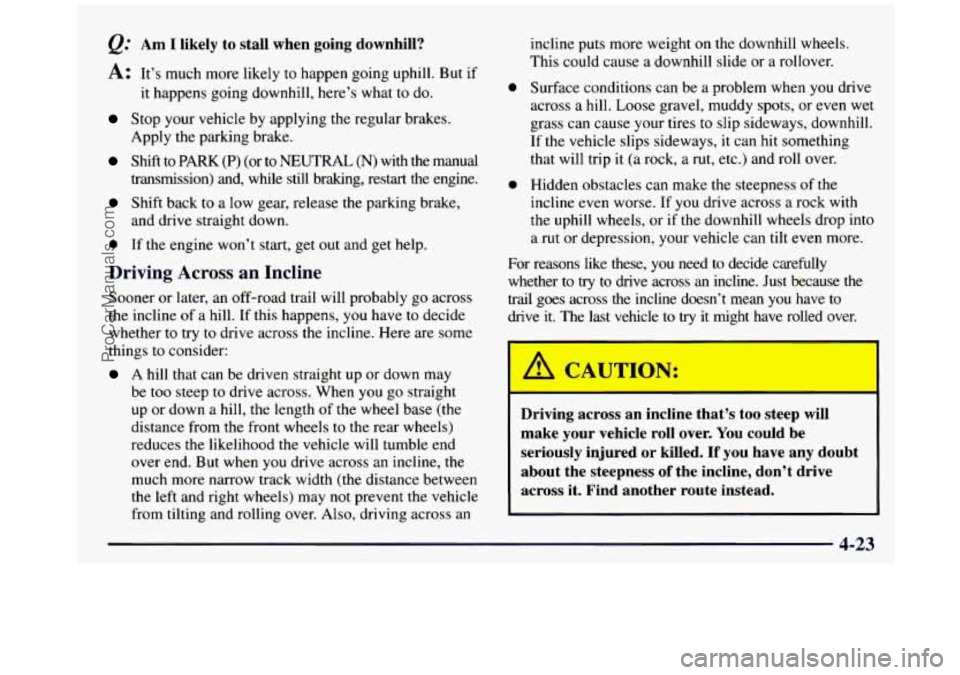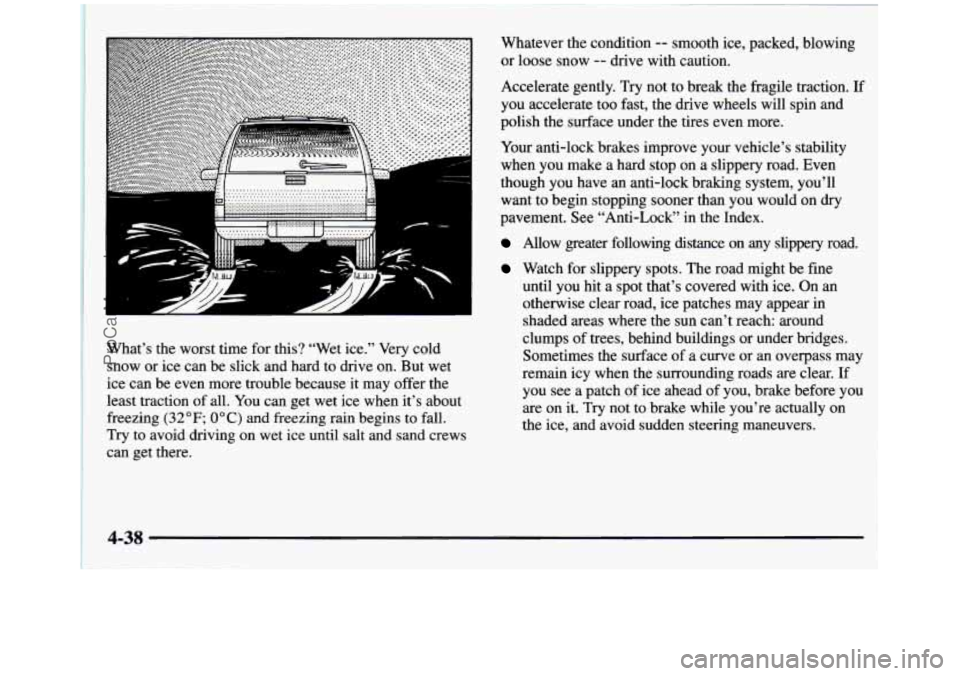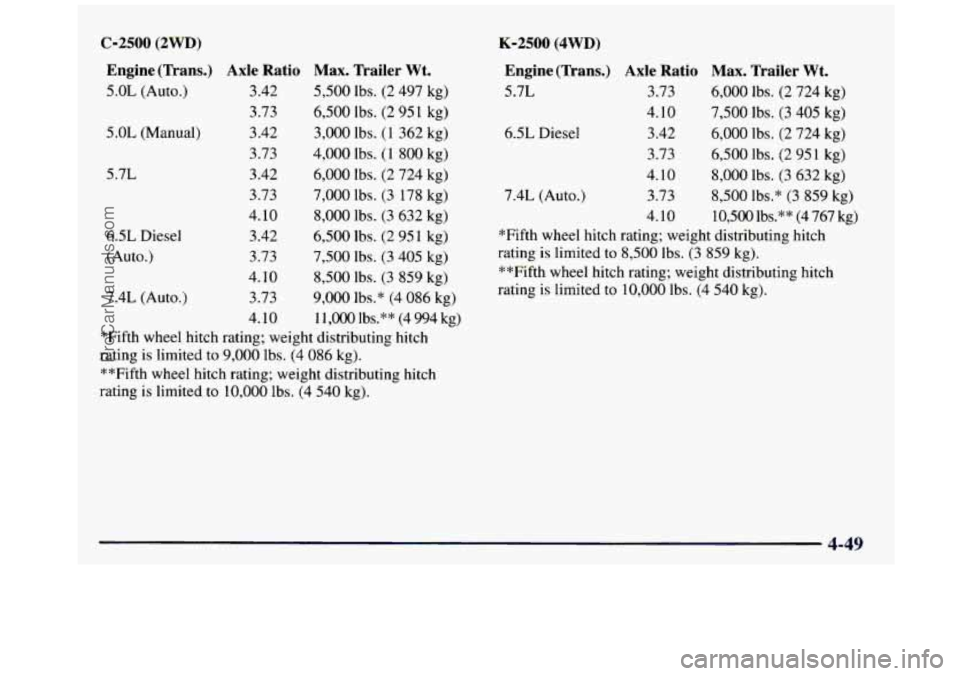1997 GMC SIERRA wheel
[x] Cancel search: wheelPage 200 of 436

Driving Downhill
When off-roading takes you downhill, you 11 want to
consider
a number of things:
How steep is the downhill? Will I be able to maintain
What’s the surface like? Smooth? Rough? Slippery?
Are there hidden surface obstacles? Ruts? Logs?
What’s at the bottom of the hill? Is there a hidden
vehicle control?
Hard-packed dirt? Gravel?
Boulders?
creek bank or even a river bottom with large rocks?
If you decide you can go down a hill safely, then try to
keep your vehicle headed straight down, and use a low
gear. This way, engine drag can help your brakes and
they won’t have to do all the work. Descend slowly,
keeping your vehicle under control at all times.
I a CAUTIO, .:
0
0
Heavy braking when going down a hill can cause
your brakes to overheat and fade. This could
cause loss of control and
a serious accident.
Apply the brakes lightly when descending a
hill and use a low gear to keep vehicle speed
under control.
&: Are there some things I should not do when
A: Yes! These are important because if you ignore them
driving down a hill?
you could lose control and have a serious accident.
When driving downhill, avoid turns that take you
across the incline
of the hill. A hill that’s not too
steep to drive down may be too steep to drive across.
You could roll over if you don’t drive straight down.
Never
go downhill with the transmission in
NEUTRAL
(N), or with the clutch pedal depressed
in a manual shift. This is called “free-wheeling.”
Your brakes will have to do all the work and could
overheat and fade.
4-22
ProCarManuals.com
Page 201 of 436

Am I likely to stall when going downhill?
A: It’s much more likely to happen going uphill. But if
it happens going downhill, here’s what to do.
Stop your vehicle by applying the regular brakes.
Apply the parking brake.
Shift to PARK (P) (or to NEUTRAL (N) with the manual
transmission) and, while still braking, restart
the engine.
Shift back to a low gear, release the parking brake,
and drive straight down.
e If the engine won’t start, get out and get help.
Driving Across an Incline
Sooner or later, an off-road trail will probably go across
the incline of a hill. If this happens, you have to decide
whether to try to drive across the incl.ine. Here are some
things to consider:
A hill that can be driven straight up or down may
be too steep to drive across. When you go straight
up or down
a hill, the length of the wheel base (the
distance from the front wheels to the rear wheels)
reduces
the likelihood the vehicle will tumble end
over end. But when you drive across an incline, the
much more narrow track width (the distance between
the left and right wheels) may not prevent the vehicle
from tilting and rolling over. Also, driving across
an
e
e
incline puts more weight on the downhill wheels.
This could cause a downhill slide or
a rollover.
Surface conditions can be a problem
when you drive
across
a hill. Loose gravel, muddy spots, or even wet
grass can cause your tires
to slip sideways, downhill.
If the vehicle slips sideways, it can hit something
that will trip it (a rock, a rut, etc.) and roll over.
Hidden obstacles can make the steepness of
the
incline even worse. If you drive across a rock with
the uphill wheels, or if the downhill wheels drop into
a
rut or depression, your vehicle can tilt even more.
For reasons like these, you need to decide carefully
whether
to try to drive across an incline. Just because the
trail
goes across the incline doesn’t mean you have to
drive it. The last vehicle to
try it might have rolled over.
Driving across an incline that’s too steep will
make your vehicle roll over.
You could be
seriously injured or killed.
If you have any doubt
about the steepness
of the incline, don’t drive
across it. Find another route instead.
ProCarManuals.com
Page 203 of 436

Driving in Mud, Sand, Snow or Ice
When you drive in mud, snow or sand, your wheels
won’t get good traction.
You can’t accelerate as quickly,
turning is more difficult, and you’ll need longer
braking distances.
It’s best
to use a low gear when you’re in mud -- the
deeper the mud, the lower the gear.
In really deep mud,
the idea is to keep your vehicle moving
so you don’t
get stuck.
When you drive
on sand, you’ll sense a change in wheel
traction. But it will depend upon how loosely packed the
sand is.
On loosely packed sand (as on beaches or sand
dunes) your tires will tend
to sink into the sand. This has
an effect on steering, accelerating and braking. You may
want to reduce the air pressure in your tires slightly
when driving on sand. This will improve traction.
Hard packed snow and ice offer the worst tire traction.
On these surfaces, it’s very easy to lose control. On wet
ice, for example, the traction is
so poor that you will
have difficulty accelerating. And
if you do get moving,
poor steering and difficult braking can cause you to slide
out of control.
Driving on frozen lakes, ponds or rivers can be
~ dangerous. Underwater springs, currents under
the ice, or sudden thaws can weaken the ice. Your
vehicle could fall through the ice and you and
your passengers could drown. Drive your vehicle
on safe surfaces only.
Driving in Water
Light rain causes no special off-road driving problems.
But heavy rain can mean flash flooding, and flood
waters demand extreme caution.
Find out how deep
the water is before you drive through
it.
If it’s deep enough to cover your wheel hubs, axles or
exhaust pipe, don’t try it
-- you probably won’t get
through. Also, water that deep can damage your axle
and other vehicle parts.
ProCarManuals.com
Page 204 of 436

If the water isn’t too deep, then drive through it slowly.
At fast speeds, water splashes on your ignition system
and your vehicle can stall. Stalling can also occur
if you
get your tailpipe under water. And, as long as your
tailpipe is under water, you’ll never be able
to start your
engine. When you go through water, remember that when
your brakes get wet, it may
take you longer to stop.
ki CAU IN:
Driving through rushing water can be dangerous.
Deep water can sweep your vehicle downstream
and you and your passengers could drown.
If it’s
only shallow water, it can still wash away the
ground from under your tires, and
you could lose
traction and roll the vehicle
over. Don’t drive
through rushing water.
After Off-Road Driving
Remove any brush or debris that has collected on
the underbody, chassis or under the hood. These
accumulations can be
a fire hazard.
After operation
in mud or sand, have the brake linings
cleaned and checked. These substances can cause
glazing and
uneven braking. Check the body structure,
steering, suspension, wheels, tires and exhaust system
for damage. Also, check
the fuel lines and cooling
system for any leakage.
Your vehicle will require more frequent service due to
off-road use. Refer to the Maintenance Schedule for
additional information.
See “Driving Through Water”
in the Index for more
information on driving through water.
4-26
ProCarManuals.com
Page 213 of 436

Highway Hypnosis
Is there actually such a condition as “highway hypnosis”?
Or is it just plain falling asleep at the wheel? Call it
highway hypnosis, lack
of awareness, or whatever.
There is something about an easy stretch
of road with the
same scenery, along with the hum of the tires on the road,
the drone of the engine, and
the rush of the wind against
the vehicle that can make you sleepy. Don’t let it happen
to you! If it does, your vehicle can leave the road in
less
than a second, and you could crash and be injured.
What can you do about highway hypnosis? First, be
aware that it can happen.
Then here are some tips:
0
e
0
Make sure your vehicle is well ventilated, with a
comfortably cool interior.
Keep your eyes moving. Scan the road ahead
and
to the sides, Check your mirrors and your
instruments frequently.
If you get sleepy, pull off the road into
a rest, service
or parking area and take a nap, get some exercise, or
both. For safety, treat drowsiness
on the highway as
an emergency.
Hill and Mountain Roads
Driving on steep hills or mountains is different from
driving in flat or rolling terrain.
4-35
ProCarManuals.com
Page 216 of 436

.............. .............
I
What’s the worst time for this? “Wet ice.” Very cold
snow or ice can be slick and hard to drive on. But wet
ice can be even more trouble because it may offer the
least traction of all. You can get wet ice when it’s about
freezing
(32°F; 0°C) and freezing rain begins to fall.
Try to avoid driving on wet ice until salt and sand crews
can get there.
.,
..
Whatever the condition -- smooth ice, packed, blowing
or loose snow
-- drive with caution.
Accelerate gently.
Try not to break the fragile traction. If
you accelerate too fast, the drive wheels will spin and
polish the surface under the tires even more.
Your anti-lock brakes improve your vehicle’s stability
when you make a hard stop on a slippery road. Even
though you have an anti-lock braking system, you’ll
want to begin stopping sooner than you would on
dry
pavement. See “Anti-Lock” in the Index.
Mow greater following distance on any slippery road.
Watch for slippery spots. The road might be fine
until you hit a spot that’s covered with
ice. On an
otherwise clear road, ice patches may appear in
shaded areas where the sun can’t reach: around
clumps of trees, behind buildings or under bridges.
Sometimes the surface
of a curve or an overpass may
remain icy when the surrounding roads are clear. If
you see a patch
of ice ahead of you, brake before you
are on it.
Try not to brake while you’re actually on
the ice, and avoid sudden steering maneuvers.
4-38
ProCarManuals.com
Page 222 of 436

Here is an example of proper truck and camper match:
r ‘J
A. Camper Center of Gravity
B. Recommended Center of Gravity Location Zone
The camper’s center
of gravity should fall within the
center of gravity zone for your vehicle’s cargo load.
You must weigh any accessories or other equipment that
you add to your vehicle. Then, subtract this extra weight
from the CWR. This extra weight may shorten the
center of gravity zone of your vehicle. Your dealer can
help
you with this.
If your slide-in camper and its load weighs less than the
CWR, the center
of gravity zone for your vehicle may
be larger. Your
dealer can help you make a good vehicle-camper
match. He’ll also help
you determine your CWR.
After
you’ve loaded your vehicle and camper, drive to a
weigh station and weigh the front and rear wheels
separately. This will tell you the loads on your axles.
The loads
on the front and rear axles shouldn’t be more
than either of
the GAWRs. The total of the axle loads
should not be more than
the GVWR.
Open your driver’s door and look at the
CertificationRire label to find out your GAWR
and GVWR.
If you’ve gone over your weight ratings, move or take
out some things until all the weight falls below the
ratings. Of course, you should always tie down any
loose items when you load your vehicle or camper.
When
you install and load your slide-in camper, check
the manufacturer’s instructions.
If you want more information
on curb weights, cargo
weights, Cargo Weight Rating and the correct center
of
gravity zone for your vehicle, your dealer can help you.
Just ask for a copy of “Consumer Information,
Truck-Camper Loading.”
4-44
ProCarManuals.com
Page 227 of 436

C-2500 (2WD) K-2500 (4WD)
5 .OL (Manual)
5.7L
Engine (Trans.) Axle Ratio Max. Trailer Wt.
5.0L (Auto.) 3.42 5,500 lbs. (2 497 kg)
3.42 3,000 lbs.
(1 362 kg)
3.42 6,000 lbs. (2 724 kg)
4.10
8,000 lbs. (3 632 kg)
6.5L Diesel 3.42 6,500 lbs. (2 951 kg)
(Auto.) 3.73
7,500 lbs. (3 405 kg)
4.10 8,500 lbs. (3 859 kg)
7.4L (Auto.) 3.73 9,000 lbs.* (4 086 kg)
4.10
1 I ,OOO lbs.** (4 994 kg)
3.73 6,500
lbs.
(2 95 1 kg)
3.73
4,000 lbs. (1 800 kg)
3.73 7,000 lbs.
(3 178 kg)
*Fifth wheel hitch rating; weight distributing hitch
rating is limited to 9,000 lbs. (4 086 kg).
**Fifth wheel hitch rating; weight distributing hitch
rating is limited to 10,000 lbs. (4 540 kg). 6.5L Diesel
Engine (Trans.) Axle Ratio Max. Trailer Wt.
5.7L
3.73 6,000 lbs. (2 724 kg)
4.10 7,500 lbs. (3 405 kg)
3.42 6,000 lbs. (2 724 kg)
4.10 8,000 lbs. (3 632 kg)
7.4L (Auto.) 3.73
8,500 lbs.* (3 859 kg)
4.10 10,500 lbs.** (4 767 kg)
*Fifth wheel hitch rating; weight distributing hitch
rating is limited to
8,500 lbs. (3 859 kg).
**Fifth wheel hitch rating; weight distributing hitch
rating is limited to 10,000 lbs. (4 540 kg).
3.73
6,500 lbs.
(2 951 kg)
4-49
--
ProCarManuals.com